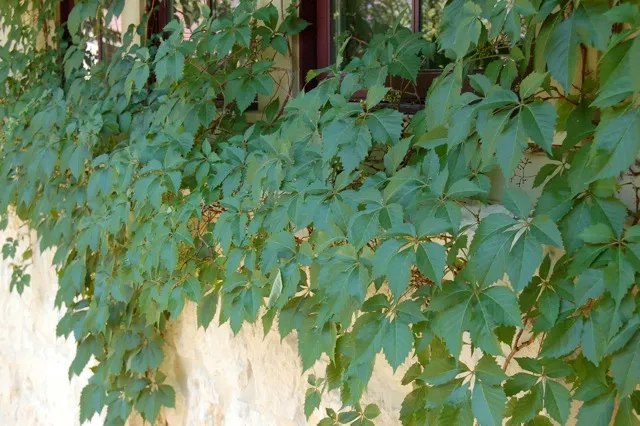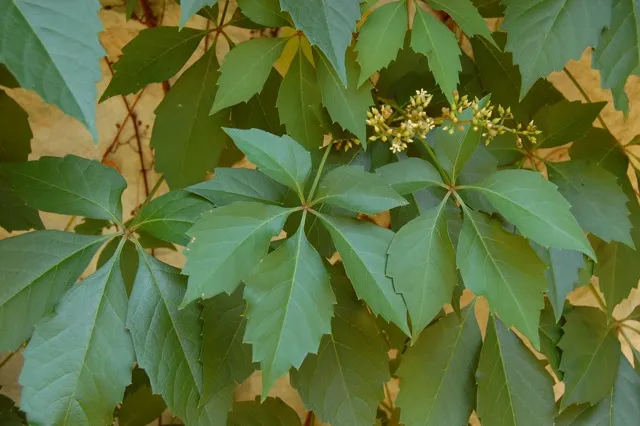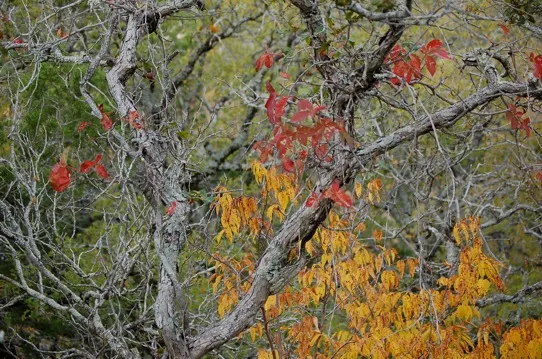By Delmar Cain
I was probably about twelve when I finally realized that I was not going to find a vine that was not attached to the ground so that I could swing from tree to tree like Tarzan. I know that I looked for that vine every time I went to play in the woods near my home. I think that I finally decided that the vines in Africa were just better than Texas vines and a rope would just have to do. But if you are not looking for one to swing on, I have a recommendation for a vine, that you will appreciate having in your yard—the Virginia creeper (Parthenocissus quinquefolia).

With a name like Virginia creeper one could legitimately ask whether it should be the recommended plant of the month for the NICE (Native Instead of Common Exotics) program of the Boerne Chapter of the Native Plant Society of Texas (NPSOT). But as a character in the movie, “Oh Brother Where Art Thou” emphatically states: “It’s bona fide”. The vine is native not only to Virginia and to Texas but also to all but eleven western states. And for a couple of centuries it has been cultivated for use in landscapes both in the United States and in many other temperate areas of the world.
With that kind of cultivation record you would think that the Virginia creeper would be long on desirables and short on negatives. And you would be correct. In its most natural habitat the vine can be found in the shade growing up the trunk of a tree. The vine also grows well in full sun and can be used for a ground cover, for screening and for erosion control. It will do well on fences and can be planted to climb and cover a building wall, a trellis or an arbor. Although it should not be used on a wooden wall because it may encourage rot due to humidity, Virginia creeper can be used on rock or brick walls because unlike some other vines it attaches by branched tendrils, which have cup-like adhesive tips.

Such versatility of use alone would make the Virginia creeper a winner. But as the kitchen utensil salesman says, “There’s more.” Probably its most striking feature is its beautiful fall color of fiery red, purple or scarlet. And when the leaves have fallen, the blue-black fruit in the form of berries left hanging on their red stems, are an attraction for fruit eating birds. The foliage of the vine, whether climbing a wall or providing ground cover will provide protection for small mammals and birds. In addition the vine is a host plant for several moths, including the Pandora sphinx (Eumorpha pandorus), the Abbott’s sphinx (Sphecodina abbotii) and the Virginia creeper sphinx (Darapsa myron).
Being native to a most of the Eastern United States, Virginia creeper can adapt to a variety of soils, including sand, loam, clay, caliche and even areas with slow drainage. When established, the vine will survive on minimal supplemental watering. In fact, its ability not only to survive but also to grow rapidly under favorable conditions is a factor that a gardener will want to consider in locating the vine. Don’t plant it where it can seed into a nearby flower bed and be prepared to prune it regularly if it moves into unwanted areas. Need I remind you to keep it out of your orchard? On the other hand if you have a yard that is mostly rocks, as I do, you might join me in applauding anything green that will grow especially with the kind of drought that we are having. I never have to worry that the soil is so rich and deep that plants get out of control.

Finally, I should note that there are some who have reported that they have had an allergic reaction to the leaves of the Virginia creeper. Others have said that Virginia creeper does not cause allergic reactions. Others have said that many people cannot distinguish Virginia creeper, which generally has five leaves, from poison ivy, which has three leaves and definitely does cause allergic reactions. Jan Wrede notes in her book “Trees, Shrubs, and Vines on the Texas Hill Country,” that the following rhyme was used to help distinguish between the two vines: “Leaves of five, let it thrive. Leaves of three let them be.” The very fact that there is a rhyme causes me to conclude that there is probably a good practical reason not to confuse the two.
Obviously I cannot resolve the debate, or definitively dispute that there may be some who are allergic to Virginia creeper. But as I indicated above, Virginia creeper has been cultivated for over 200 years and used in temperate zones around the world. Apparently many gardeners have found the pluses far outweigh the minuses for this versatile performer, which stands out in its fall show time. By the way, it provides a very attractive native alternative to the exotic (non-native) English ivy. For planting and care instructions go to the Boerne Chapter NPSOT website: (http://www.npsot.org/wp/boerne/).
